Ethnic Regions
Ethnic Regions

How are ethnic groups distributed geographically? Do ethnic culture regions have a special spatial character? Formal ethnic culture regions exist in most countries. To map these regions, geographers rely on data as diverse as probable origin of surnames in telephone directories and census totals for answers to questions on ancestry, primary racial identification, or language spoken at home. Given the cultural complexity of the real world, each method produces a slightly different map (Figure 5.7). Regardless of the mapping method, ethnic culture regions reveal a vivid mosaic of minorities in most countries of the world.

Thinking Geographically
Question
What differences are apparent in the two maps? Do you think they are the result of the way of compiling the data or of the passage of time? Why?
There are four types of ethnic culture regions: rural ethnic homelands, ethnic islands, urban ethnic neighborhoods, and urban ghettos.
Ethnic Homelands and Islands
Ethnic Homelands and Islands
ethnic homeland A sizable area inhabited by an ethnic minority that exhibits a strong sense of attachment to the region and often exercises some measure of political and social control over it.
ethnic island A small ethnic area in the rural countryside; sometimes called a folk island.
The difference between ethnic homelands and ethnic islands is their size, in terms of both area and population. Rural ethnic homelands cover large areas, often overlapping munic-ipal borders, and have sizable populations. Because of their size, the age of their inhabitants, and their geographical segregation, they tend to reinforce ethnicity. The residents of homelands typically seek or enjoy some measure of political autonomy or self-rule. Homeland populations usually exhibit a strong sense of attachment to the region. Most homelands belong to indigenous ethnic groups and include special, venerated places that serve to symbolize and celebrate the region—shrines to the special identity of the ethnic group. In its fully developed form, the homeland represents the most powerful of geographical entities, one combining the attributes of both formal and functional culture regions. By contrast, ethnic islands (sometimes called folk islands) are small dots in the countryside, usually occupying an area smaller than a county and serving as home to several hundred to several thousand people. Because of their small size and isolation, they do not exert as powerful an influence as homelands do.
125
North America includes a number of viable ethnic homelands (Figure 5.8), including Acadiana, the Louisiana French homeland now increasingly identified with the Cajun people and also recognized as a vernacular region; the Hispano or Spanish-American homeland of highland New Mexico and Colorado; the Tejano homeland of south Texas; the Navajo reservation homeland in Arizona, Utah, and New Mexico; and the French-Canadian homeland centered on the valley of the lower St. Lawrence River in Québec. Some geographers would also include Deseret, a Mormon homeland in the Great Basin of the intermontane West. Some ethnic homelands have experienced decline and decay. These include the Pennsylvania Dutch (German) homeland, weakened to the point of extinction by assimilation, and the southern Black Belt, diminished by the collapse of the plantation-sharecrop system and the resulting African-American relocation to northern urban areas. Mormon absorption into the American cultural mainstream has eroded Mormon ethnic status, whereas nonethnic immigration has diluted the Hispano homeland. At present, the most vigorous ethnic homelands are those of the French-Canadians and south Texas Mexican-Americans.
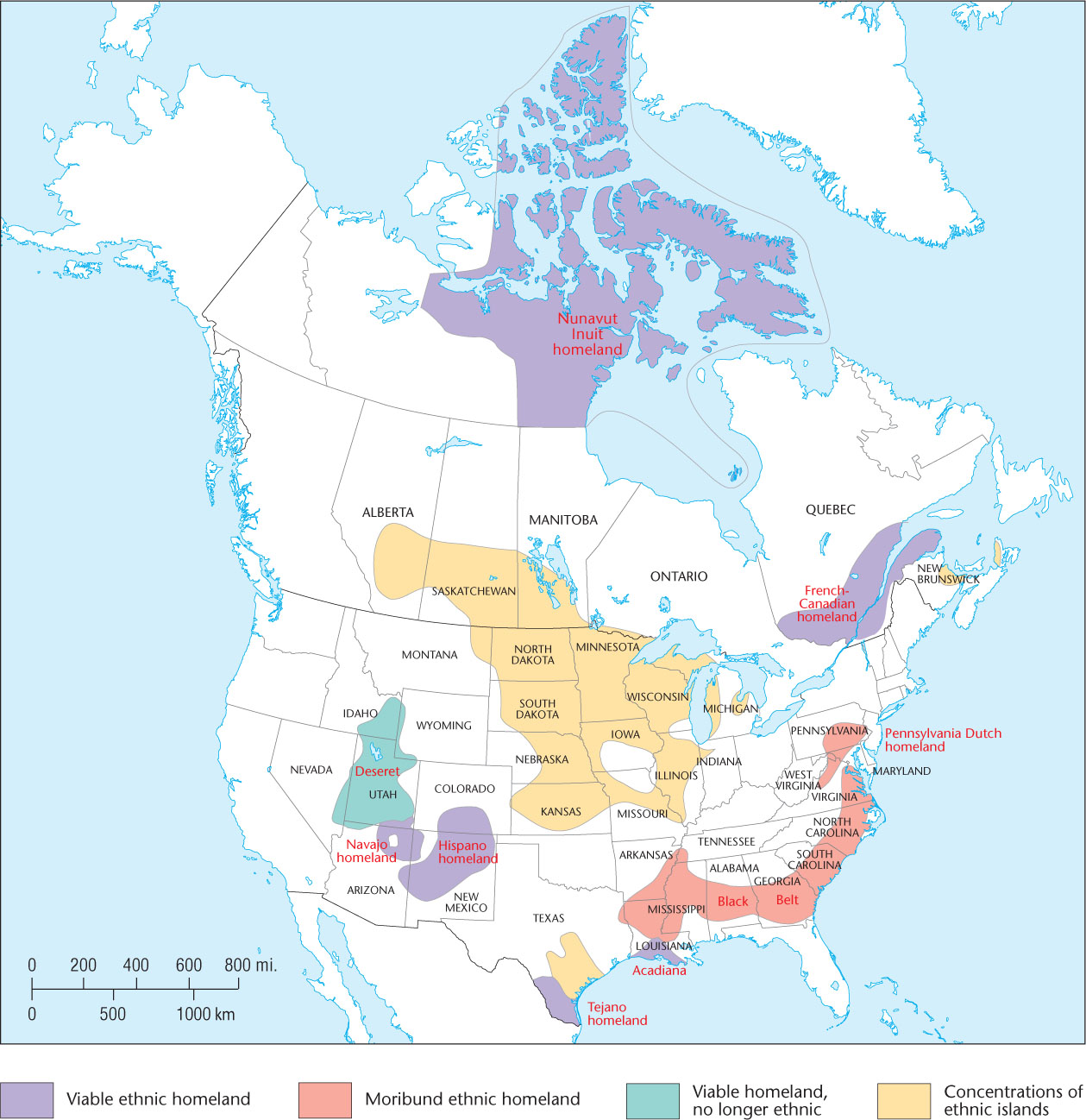
Thinking Geographically
Question
What landscape features are likely to remain even if an ethnic homeland becomes moribund?
126
ethnic substrate Regional cultural distinctiveness that remains following the assimilation of an ethnic homeland.
If ethnic homelands succumb to assimilation and their people are absorbed into the host culture, at the very least a geographical residue, or ethnic substrate, remains. The resulting culture region, though no longer ethnic, nevertheless retains some distinctiveness, whether in local cuisine, dialect, or traditions. Thus, it differs from surrounding regions in a variety of ways. In seeking to explain its distinctiveness, geographers often discover an ancient, vanished ethnicity. For example, the Italian province of Tuscany owes both its name and some of its uniqueness to the Etruscan people, who ceased to be an ethnic group 2000 years ago, when they were absorbed into the Latin-speaking Roman Empire. More recently, the massive German presence in the American heartland(Figure 5.9), now largely nonethnic, helped shape the cultural character of the Midwest, which can be said to have a German ethnic substrate.

Thinking Geographically
Question
Why are most Germans and Scandinavians found in the North?
127
Ethnic islands are much more numerous than homelands or substrates, peppering large areas of rural North America, as Figures 5.8 and 5.9 suggest. Ethnic islands develop because, in the words of geographer Alice Rechlin, “a minority group will tend to utilize space in such a way as to minimize the interaction distance between group members,” facilitating contacts within the ethnic community and minimizing exposure to the outside world. People are drawn to rural places where others of the same ethnic background are found. Ethnic islands survive from one generation to the next because most land is inherited. Moreover, land is typically sold within the ethnic group, which helps to preserve the identity of the island. Social stigma is often attached to those who sell land to outsiders. Even so, the smaller size of ethnic islands makes their populations more susceptible to acculturation and assimilation.
Ethnic Neighborhoods and Racialized Ghettos
Ethnic Neighborhoods and Racialized Ghettos
ethnic neighborhood A voluntary community where people of like origin reside by choice.
Formal ethnic culture regions also occur in cities throughout the world, as minority populations initially create, or are consigned to, separate ethnic residential quarters. Two types of urban ethnic culture regions exist. An ethnic neighborhood is a voluntary community where people of common ethnicity reside by choice. Such neighborhoods are, in the words of Peter Matwijiw, an Australian geographer, “the results of preferences shown by different ethnic groups … toward maintaining group cohesiveness.” An ethnic neighborhood has many benefits: common use of a language other than that of the majority culture, nearby kin, stores and services specially tailored to a certain group’s tastes, the presence of employment that relies on an ethnically based division of labor, and institutions important to the group—such as churches and lodges—that remain viable only when a number of people live close enough to participate in their activities often. Miami’s orthodox Jewish population clusters in Miami Beach–area neighborhoods in part because the proximity of synagogues and kosher food establishments makes religious observance far easier than it would be in a neighborhood that did not have a sizable orthodox Jewish population.
ghetto Traditionally, an area within a city where an ethnic group lives, either by choice or by force. Today in the United States, the term typically indicates an impoverished African-American urban neighborhood.
The second type of urban ethnic region is a ghetto. Historically, the term dates from thirteenth-century medieval Europe, when Jews lived in segregated, walled communities called ghettos (Figure 5.10). Ethnic residential quarters have, in fact, long been a part of urban cultural geography. In ancient times, conquerors often forced the vanquished native people to live in ghettos. Religious minorities usually received similar treatment. Islamic cities, for example, had Christian districts. If one abides by the origin of the term, ghettos neither need to be composed of racialized minorities nor be impoverished. Typically, however, the term ghetto is used in the United States today to signal an impoverished urban African-American neighborhood. A related term, barrio, refers to an impoverished urban Hispanic neighborhood. Ghettos and barrios are as much functional culture regions as formal ones.

Thinking Geographically
Question
What evidence is there that the ghetto expanded over time?
128
Coinciding with the urbanization and industrialization of North America, ethnic neighborhoods became typical in the northern United States and in Canada about 1840. Instead of dispersing throughout the residential areas of the city, immigrant groups clustered together. To some degree, ethnic groups that migrated to cities came from different parts of Europe from those who settled in rural areas. Whereas Germany and Scandinavia supplied most of the rural settlers, the cities attracted those from Ireland and eastern and southern Europe. Catholic Irish, Italians, and Poles, along with Jews from eastern Europe, became the main urban ethnic groups, although lesser numbers of virtually every nationality in Europe came to the cities of North America. These groups were later joined by French-Canadians, southern African-Americans, Puerto Ricans, Appalachian whites, Native Americans, Asians, and other non-European groups.
ethnoburb A suburban ethnic neighborhood, sometimes home to a relatively affluent immigrant population.
Regardless of their particular history, the neighborhoods created by ethnic migrants tend to be transitory. As a rule, urban ethnic groups remain in neighborhoods while undergoing acculturation. As a result, their central-city ethnic neighborhoods experience a life cycle in which one group is replaced by another, later-arriving one. We can see this process in action in the succession of groups that resided in certain neighborhoods and then moved on to more desirable areas. The list of groups that passed through one Chicago neighborhood from the nineteenth century to the present provides an almost complete history of American migratory patterns. First came the Germans and Irish, who were succeeded by the Greeks, Poles, French-Canadians, Czechs, and Russian Jews, who were soon replaced by the Italians. The Italians, in turn, were replaced by Chicanos and a small group of Puerto Ricans. As this succession occurred, the established groups had often attained enough economic and cultural capital to move to new areas of the city. In many cities, established ethnic groups moved to the suburbs. Even when ethnic groups relocated from inner-city neighborhoods to the suburbs, residential clustering survived (Figure 5.11). The San Gabriel Valley, about 20 miles (32 kilometers) from downtown Los Angeles, has developed as a major Chinese suburb. These suburban ethnic neighborhoods can house relatively affluent immigrant populations and are called ethnoburbs (Figure 5.12).

Thinking Geographically
Question
If there were no signs in these pictures, would you know that they are Chinese neighborhoods? How?

Thinking Geographically
Question
What ethnic neighborhoods exist in the city where you live?
129
Recent Shifts in Ethnic Mosaics
Recent Shifts in Ethnic Mosaics
In the United States, immigration laws have changed during the past 45 years, shifting in 1965 from the quota system based on national origins to one that allowed a certain number of immigrants from the Eastern and Western hemispheres, as well as giving preference to certain categories of migrants, such as family members of those already residing in the United States. These changes, and the rising levels of undocumented immigration, have led to a growing ethnic variety in North American cities.
gateway city A city that acts as a port of entry, early settlement area, and distribution center for immigrants to a country because of its relative proximity to the homeland.
Latin America and Asia, rather than Europe, are now the principal sources of immigrants to North America. In fact, Latin Americans now constitute 53% of the U.S. foreign-born population, with Mexicans alone (including naturalized citizens and noncitizens) accounting for about 30% of the U.S. immigrant population. This number has increased from only 8% in 1970. Due to economic push factors, the number of Mexican (documented and undocumented) immigrants to the United States is expected to continue to increase through 2050, with Mexicans remaining the largest immigrant group within the country. As shown in Figure 5.13, the distribution of Latin American immigrants within the United States is highly uneven. For example, 85% of Mexican immigrants lived in just 10 U.S. states in 2006. This unevenness is expected to continue through future decades, as new immigrants will often be drawn to areas where they have familial and social networks awaiting them. Further, immigrants often settle in gateway cities and regions that are located close to their native country. For example, California and the American southwest (bordering Mexico) and Florida (nearest Cuba and other Caribbean countries) have been popular destinations for many newcomers to the United States in recent decades.
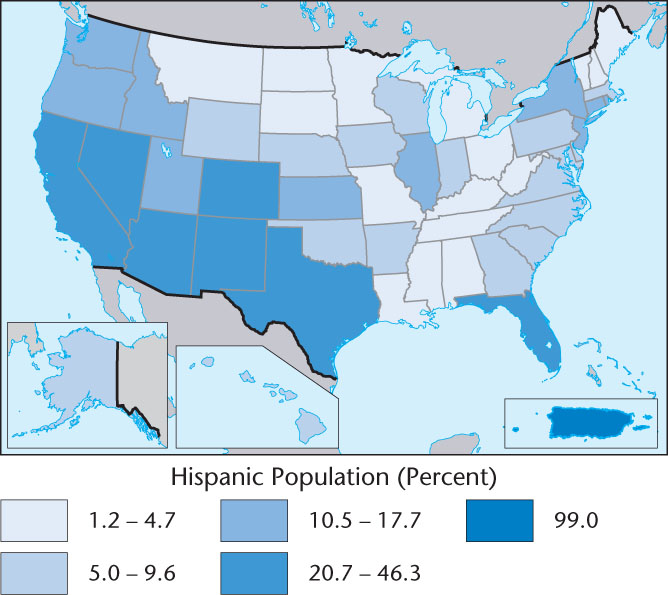
Thinking Geographically
Question
How do you explain the pattern on this map?
130
In some gateway cities, Hispanic or Latino immigrants now constitute large segments of new “minority majority” populations. For example, the population of Los Angeles is now more than 50 percent nonwhite (excluding Hispanic-white). Other cities like Las Vegas and San Diego also now have similarly nonwhite majorities. Table 5.1 lists the cities in the United States with the highest ethnic concentrations. This table makes it clear that the attraction of immigrants to certain gateway cities (and their suburbs) and other major urban centers has greatly impacted the ethnic mosaics of these places. It is interesting to note that Hialeah, Florida (a suburb of Miami), is the most “white” city of over 100,000 residents, but it is also the third-most “Hispanic” city in the United States. As noted in the table, this apparent contradiction in data is possible because all racial categories denoted by the U.S. Census overlap the ethnic categories Hispanic and Latino. In other words, a person of Hispanic or Latino ethnicity can elect to identify herself or himself as a member of any of the racial categories within the Census or as ethnically Hispanic. This intersection of race and ethnicity in the U.S. Census highlights the complexities and ambiguity associated with collecting and tabulating data regarding these categorizations in an increasingly diverse population. Figure 5.3 illustrates racial and ethnic breakdowns for the U.S. population as a whole. In this figure, again, the “Hispanic origin” population includes people of any racial classification. We can see from this figure that when only “non-Hispanic whites” are counted, the population of the United States has become less “white” and more “Hispanic” since 1990. The projections in Figure 5.3 show that these trends are set to continue at least through the year 2050.
Table 5.1:
U.S. Cities of 100,000 or More with the Highest Ethnic Concentrations
| Largest Concentration | Second-Largest Concentration | Third-Largest Concentration | |
|---|---|---|---|
| African-American | Detroit, MI (82.7%) | Jackson, MS (79.4%) | Miami Gardens, FL (76.3%) |
| White | Hialeah, FL (92.6%) | Fargo, ND (90.2%) | Arvada, CO (89.8%) |
| Hispanic | East Los Angeles, CA (97.1%) | Laredo, TX (95.6%) | Hialeah, FL (94.7%) |
| Asian | Daly City, CA (55.6%) | Honolulu, HI (54.8%) | Fremont, CA (50.6%) |
| The figures for African-Americans, whites, and Asians are for that category alone, not in combination with other races. The figures for Hispanics can include any racial designation. In U.S. Census documents, the designationwhite overlaps, as do all other official racial categories, with the term Hispanic or Latino, which was introduced in the 1980 Census as a category of ethnicity, separate and independent of race. Hispanic and Latino Americans make up a racially diverse group, and as a whole compose the largest minority in the country. (Source: U.S. Bureau of the Census, 2010.) | |||
The second-largest source region for contemporary immigrants to the United States is Asia. Asians constitute nearly 28% of all immigrants in the United States today; they accounted for just over 5% in 1960. China, the Philippines, and India are currently the largest source countries for Asian immigrants to the United States. As with immigrants of Hispanic origin, the distribution of Asian immigrants within the United States (as well as Canada) is uneven. In the United States, the West Coast is home to nearly 50 percent of the Asian population, mostly in California, with another concentration occurring in the urban corridor that stretches from New York City to Boston and further concentrations occurring in Illinois and Texas (Figure 5.14). In Hawaii, people of Japanese ancestry form the largest national-origin group, with 57 percent of the state’s population claiming Asian (or multiracial Asian) ancestry. Because they are relatively close to Asia, many West Coast cities in both the United States and Canada have acted as gateway cities to Asian immigrants over the past several decades. For example, Vancouver has absorbed many Asian immigrants for decades, but shortly preceding the 1997 return of Hong Kong to the People’s Republic of China (and continuing since that time), many Chinese immigrants dramatically increased these numbers. People of Chinese origin now constitute the third-largest ethnic-origin group in the city, accounting for more than 19 percent of the current population.

Thinking Geographically
Question
How do you explain the pattern you see here?
131
As ethnic populations continue to concentrate in gateway cities, a large swath of the United States has remained largely non-Hispanic white (Figure 5.15). Table 5.2 shows the 10 most-identified ancestries among this segment of the U.S. population. However, these ancestries do not take into consideration the 54.4% of residents who chose to identify themselves as American or Other or simply declined to report their ethnicity in the U.S. Census. This large percentage is another reflection of the increasingly complex nature of U.S. ethnicity. Fewer and fewer people are able (or wish) to identify themselves by a single ancestry. Where ancestry is identified, it is increasingly less European when compared to figures from earlier periods in U.S. history.
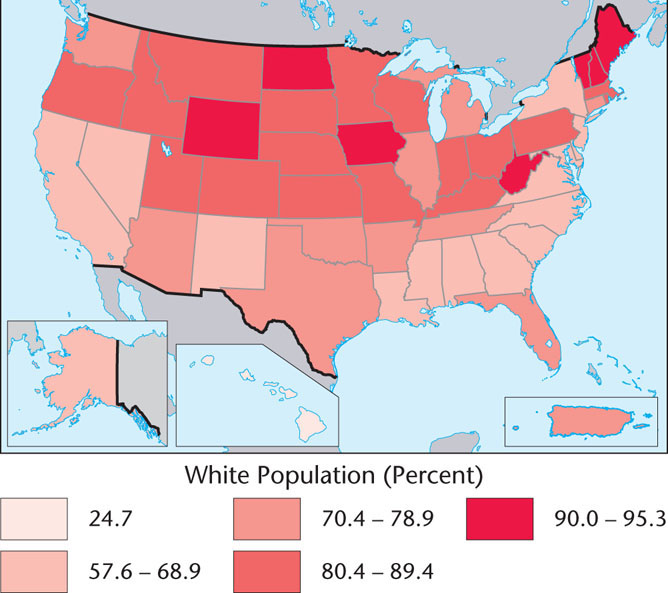
Thinking Geographically
Question
How do you explain the patterns on this map?
Table 5.2:
Top 10 Most-Identified Ancestries as a Percentage of the Total U.S. Population*
| Ancestry Group | Percentage of Total U.S. Population |
|---|---|
| German | 16.5 |
| Irish | 12.0 |
| English | 9.0 |
| Italian | 5.9 |
| Polish | 3.3 |
| French (except Basque) | 3.1 |
| Scottish | 1.9 |
| Dutch | 1.6 |
| Norwegian | 1.5 |
| Swedish | 1.4 |
| *Does not include those individuals who identified themselves as Other or American or who chose not to classify or report their ancestry. (Source: U.S. Bureau of the Census, 2009.) | |
In examining other segments of the U.S. population, Figure 5.16 and Figure 5.17 show that African-Americans, American Indians, and Alaska Natives are also somewhat spatially concentrated. Although the United States is becoming increasingly diverse as a nation, within specific regions of the country the United States is not always the melting pot it is portrayed to be.
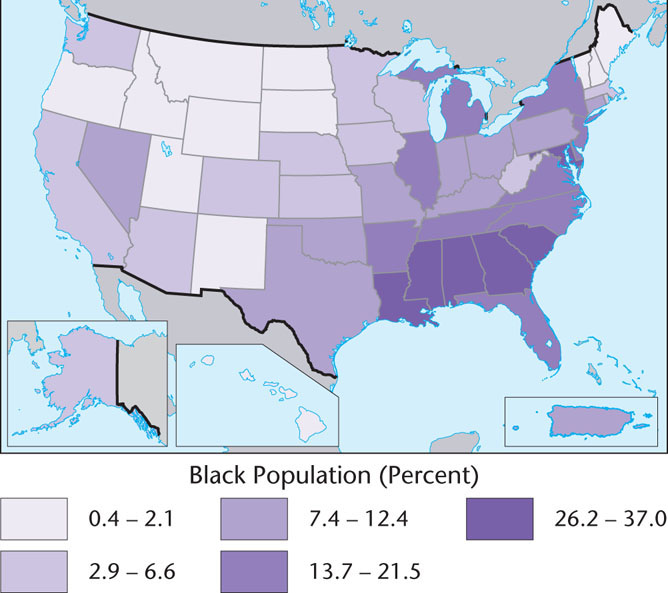
Thinking Geographically
Question
How do you explain the patterns on this map?
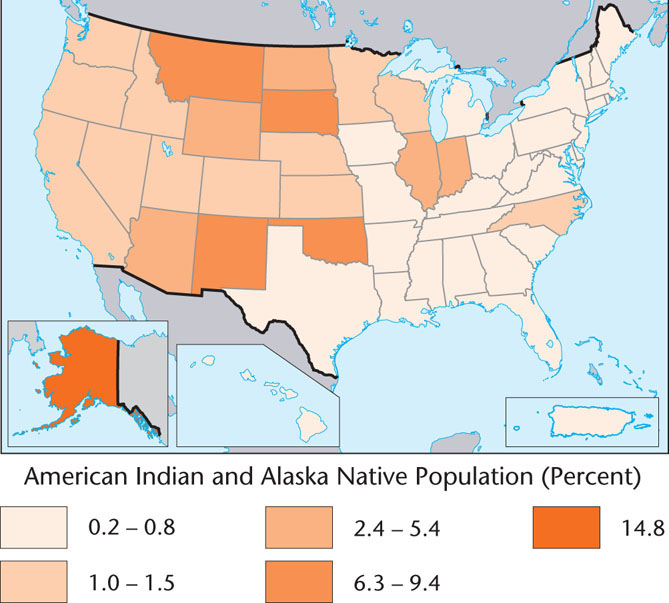
Thinking Geographically
Question
How do you explain the patterns on this map?
132
Outside the United States and Canada, many world regions are also experiencing increasing racial and ethnic diversity, as well as similar unevenness in the distribution of ethnic groups within particular areas. In recent decades the countries of western Europe have attracted large numbers of immigrants, mainly from Eastern Europe, Africa, Asia, and the Middle East. For example, Ireland, once a highly monocultural nation, now has approximately 11 percent foreign-born residents, many of them newly arrived from Poland, Nigeria, and Pakistan. Many of these immigrants are concentrated in Dublin and other major cities where employment opportunities have historically been most abundant for newcomers.
Similarly significant increases in ethnic diversity have occurred in the populations of France (nearly 6 percent foreign-born), Iceland (nearly 8 percent foreign-born), and Germany (nearly 9 percent foreign-born). These dramatic demographic shifts have sparked heated controversies between various factions within the governments and citizenries regarding immigration laws, access to employment, and the provision of state benefits to foreign-born residents. The concentration of large numbers of immigrants in European urban centers has raised tensions in cities such as Paris, leading to public demonstrations and outbreaks of violence on both sides of the ongoing immigration debate.
The Middle East, South America, Australia, and parts of East and Southeast Asia have also experienced dramatic shifts in their ethnic compositions. In Southeast Asia, many Chinese people have immigrated to countries such as Indonesia, Thailand, and Malaysia. As Figure 5.18 illustrates, the presence of this foreign-born population has impacted the cultural landscapes of these countries, as many Chinese entrepreneurs become successful business owners in their adopted homelands. In Argentina and Brazil, large ethnic populations have developed as well, with many Japanese migrating to these countries. Parts of East Africa are home to relatively affluent South Asian Indian populations, whereas Lebanese populations in West Africa enjoy a similarly privileged position. Increasing globalization and urbanization throughout the world appear likely to ensure that the trend toward ethnic diversity will continue in many world regions in coming decades.

Thinking Geographically
Question
Why don’t Polynesians own such stores?